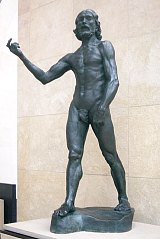7. The suggestion of movement
Rodin´s referral to Barye points to a key feature in Rodin´s own work. In his conversations with Gsell, the sculptor explains how his work John the Baptist suggests movement to the spectator: "Now,
the illusion of life is obtained in our art by good
modelling and by movement.(..)
"Note, first, that movement is the transition from
one attitude to another. (...)
"You have certainly read in Ovid how Daphne was
transformed into a bay-tree and Procne into a swallow.
(...) In each of them one still sees the woman which will
cease to be and the tree or birds which she will become.
"It is, in short, a metamorphosis of this kind that
the painter or the sculptor effects in giving movement to
his personages. He represents the transition from one pose
to another - he indicates how insensibly the first glides
into the second. In his work we still see a part of what
was and we discover a part of what is to be. (...)
"Now, for example, while my Saint John is represented
with both feet on the ground, it is probable that an
instantaneous photograph from a model making the same
movement would show the back feet already raised and
carried forward to the other. Or else, on the contrary,
the front feet would not yet be on the ground if the back
leg occupied in the photography the same positions as in
my statue.
|

John the Baptist,
Musée d´Orsay.
Photo: William
Allen
|
"Now
it is exactly for that reason that this model photographed
would present the odd appearance of a man suddenly
stricken with paralysis and petrified in his pose (..)
"If, in fact, in instantaneous photographs, the
figures, though taken while moving, seem duddenly fixed in
mid-air, it is because, all parts of the body being
reproduced exactly at the same twentieth or fortieth of a
seconds, there is no progressive development of movement
as there is in art. (...)
"It is the artist who is truthful and it is
photography which lies, for in reality time does not stop,
and if the artist succeeds in producing the impression of
a movement which takes several moments for accomplishment,
his work is certainly much less conventional than the
scientific image, where time is abruptly suspended.  Paul Gsell, Rodin on Art and Artistst, Dover Publications, New York, p.
32ff.
Paul Gsell, Rodin on Art and Artistst, Dover Publications, New York, p.
32ff.


|
